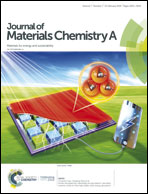Direct solar-to-hydrogen generation by quasi-artificial leaf approach: possibly scalable and economical device†
Abstract
Often, a disadvantage in one area of science may become an advantage in another area. In contrast, a successful concept in one area could work for a complementary area of research too. These two philosophies have been successfully used for solar hydrogen generation and they underscore the necessity to connect relevant concepts. We, herein, report a quasi-artificial leaf (QuAL) device in a wireless configuration with a TiO2/Mn–CdS composite and NiCu as a co-catalyst for possibly scalable as well as commercially viable solar hydrogen production under one sun conditions. The device works at no applied potential and generates 10.5 mL h−1 (16 mL h−1) H2 with Ni5Cu2.5 alloy (Pt) as a co-catalyst, which corresponds to a power conversion efficiency (PCE) of 4.8% (7.3%). The significant resemblance of NiCu alloy to Pt in terms of its electrochemical activity and electronic structure makes the device more economical. While the millisecond lifetime of electrons in Mn–CdS is known to help for white light emission, the same factor helps to greatly improve charge utilization for H2 production in the QuAL device. In contrast, the reabsorption of emitted light is a vexing problem in emission applications; however in the present work, reabsorption is successfully utilized to enhance hydrogen yield. Spectroscopy techniques combined with electrocatalytic studies were employed and the results correlated with solar hydrogen generation, demonstrating this as a new pathway to design better solar-light-harvesting architectures.



 Please wait while we load your content...
Please wait while we load your content...